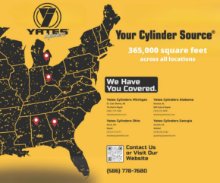United States Steel Reports 2010 Q3 Results
10/27/2010 - United States Steel Corp. reported a third-quarter 2010 net loss of $51 million, or $0.35 per diluted share, compared to a net loss of $25 million, or $0.17 per diluted share, in the second quarter of 2010 and a net loss of $303 million, or $2.11 per diluted share, in the third quarter of 2009.
United States Steel Corp. reported a third-quarter 2010 net loss of $51 million, or $0.35 per diluted share, compared to a net loss of $25 million, or $0.17 per diluted share, in the second quarter of 2010 and a net loss of $303 million, or $2.11 per diluted share, in the third quarter of 2009.
"Results for the quarter were lower than the second quarter as all three of our segments had lower shipments and production as activity in most of our markets slowed,” said U. S. Steel Chairman and CEO John P. Surma. “Results were also affected by higher facility repair and maintenance costs, most notably for inspection and repairs of critical structures at our Flat-rolled facilities, lower Flat-rolled average realized prices, and higher raw materials costs in our Flat-rolled and European operations. Our Tubular operations benefited from increased average realized prices and had improved income from operations for the fifth consecutive quarter."
The company reported a Q3 2010 loss from operations of $138 million, compared with income of $198 million in the second quarter and a loss from operations of $412 million in the third quarter of 2009.
Other items not allocated to segments in the third quarter consisted of a loss from the sale of the majority of the assets of Fintube Technologies, which decreased net income by $15 million, or $0.11 per diluted share. There were no other items not allocated to segments during the second quarter of 2010 or the third quarter of 2009.
Net interest and other financial costs in Q3 included a foreign currency gain that increased net income by $139 million, or $0.96 per diluted share. The net gain primarily resulted from the accounting remeasurement of a $1.6 billion U.S. dollar-denominated intercompany loan to a European subsidiary, partially offset by losses on euro-U.S. dollar derivatives activity. This compares to a foreign currency loss that decreased net income by $96 million, or $0.62 per diluted share, in the second quarter and a foreign currency gain that increased net income by $24 million, or $0.16 per diluted share, in the third quarter of 2009.
For the nine months ended September 30, 2010, the company recorded a tax provision of $56 million on its pre-tax loss of $177 million. Third-quarter 2010 results included a $29 million, or $0.20 per diluted share, favorable catch-up adjustment as a result of a decrease in the estimated annual effective tax rate.
As of September 30, 2010, U. S. Steel had $643 million of cash and $2.2 billion of total liquidity as compared to $947 million of cash and $2.5 billion of total liquidity at June 30, 2010.
Reportable segments and other businesses– U. S. Steel's reportable segments and Other Businesses reported a loss from operations of $80 million, or $14 per ton, in the third quarter, compared to income of $241 million, or $41 per ton, in the second quarter of 2010 and a loss from operations of $379 million, or $91 per ton, in the third quarter of 2009.
Income from operations for Flat-rolled was lower than the second quarter 2010 primarily due to decreased shipments and production volumes, decreased average realized prices, increased costs for facility repair and maintenance, and consumption of higher cost coal, coke, and iron ore purchased to support earlier facility restarts. Facility repair and maintenance costs were significantly higher than the second quarter primarily due to more extensive structural inspection and repair activities as well as normal scheduled outage work at both Gary Works and Great Lakes Works.
Costs associated with expedited repairs from previously completed and current inspection activities were $80 million in the third quarter, an increase of $60 million over the second quarter. Approximately half of the amount incurred in the third quarter related to blast furnace raw material transportation system structures at Gary Works, including the section that failed, as well as similar structures at Great Lakes Works.
Average realized prices in the third quarter of 2010 were $688 per net ton, a $12 per ton decrease from the second quarter of 2010 as decreased spot market prices more than offset the benefits of increased contract prices. Shipments decreased by 6% to 3.8 million tons due to lower order rates, reflecting the lack of recovery in the construction markets and normal seasonal patterns. The raw steel capability utilization rate was 77% for the Flat-rolled segment, lower than the second quarter.
Third-quarter results for U. S. Steel Europe (USSE) were lower than the second quarter as the benefits of higher euro-based transaction prices were more than offset by higher raw materials costs and increased facility repair and maintenance costs. Costs associated with structural inspection and repair activities at USSE totaled $3 million in the third quarter, an increase of $2 million from the second quarter.
Reported average realized prices increased by $61 per ton to $748 per ton. Shipments decreased by 4% to 1.3 million tons due to reduced order rates from our spot market customers and normal seasonal patterns. USSE operated at 77% of raw steel capability for the third quarter as it idled a blast furnace at U. S. Steel Serbia for part of the quarter in response to lower order rates and completed planned maintenance work on a blast furnace at U. S. Steel Kosice.
Q3 results for Tubular improved over the second quarter as the benefits of higher average realized prices and decreased costs for steel substrate were only partially offset by slightly lower shipments, primarily carbon OCTG and welded line pipe, and increased facility repair and maintenance costs.
Costs associated with structural inspection and repair activities totaled $3 million in the third quarter compared to an immaterial amount in the second quarter. Shipments decreased by 3% to 422,000 tons, and the reported average realized price for the segment increased by $63 per ton to $1,559 per ton.
Third-quarter 2010 results for Other Businesses were lower than the second quarter of 2010 primarily due to the impact of a land sale by our real estate operations in the second quarter.
Outlook – Commenting on U. S. Steel's outlook, Surma said, "Our current order entry rates reflect the uncertain economic situation in North America and Europe, with spot customers reducing inventory levels in light of short lead times, while our contractual customers' order rates are consistent with traditional downtime taken late in the fourth quarter."
Fourth-quarter results for Flat-rolled are expected to be in line with the third quarter as reduced spending for facility repair and maintenance, including structural inspections and repairs, and the absence of operating inefficiencies at Gary Works due to the structural failure will be offset by decreased average realized prices and lower shipments and production volumes.
The company expects to continue to incur costs for structural repairs, but anticipate they will be lower than the third quarter by approximately $40 million, as much of the significant repair work was completed in the third quarter. The expected decrease in average realized prices is a result of lower spot market and index-based contract prices. The company expects a decrease in shipments as a result of normal seasonal patterns and will adjust its blast furnace configuration to coincide with order rates.
The company expects to operate at an overall lower raw steel capability utilization rate than in the third quarter as its Hamilton Works blast furnace was idled in October in response to reduced order rates in Canada and the United States and scheduled maintenance work.
U. S. Steel expects Q4 results for USSE to be comparable to the third quarter as lower raw materials costs and reduced spending on facility repair and maintenance are offset by lower shipments. While it expects lower euro-based transaction prices in the fourth quarter, the overall euro-based average price is expected to be higher as a result of a higher mix of value-added contract shipments. The company expects raw steel capability utilization rates to be lower than the third quarter as it idled a blast furnace at U. S. Steel Serbia in response to reduced order rates.
The Tubular segment is expected to remain profitable in the fourth quarter, but lower results as compared to the third quarter. Customer inventory levels are at the high end of the normal range. The company says its program customers and distributors are actively controlling their inventory levels going into year end. In addition, imports, particularly from South Korea, have increased. As a result, the company expects lower shipments and average realized prices, partially offset by lower costs for steel substrate.






